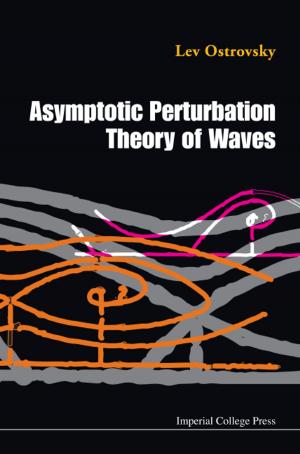Handbook of Biomimetics and Bioinspiration
Biologically-Driven Engineering of Materials, Processes, Devices, and Systems(In 3 Volumes)
Nonfiction, Science & Nature, Science, Biological Sciences, Biochemistry, Technology, Engineering, Health & Well Being, Medical| Author: | Esmaiel Jabbari, Luke P Lee;Amir Ghaemmaghami;Ali Khademhosseini, Deok―Ho Kim | ISBN: | 9789814520270 |
| Publisher: | World Scientific Publishing Company | Publication: | March 19, 2014 |
| Imprint: | WSPC | Language: | English |
| Author: | Esmaiel Jabbari, Luke P Lee;Amir Ghaemmaghami;Ali Khademhosseini, Deok―Ho Kim |
| ISBN: | 9789814520270 |
| Publisher: | World Scientific Publishing Company |
| Publication: | March 19, 2014 |
| Imprint: | WSPC |
| Language: | English |
Global warming, pollution, food and water shortage, cyberspace insecurity, over-population, land erosion, and an overburdened health care system are major issues facing the human race and our planet. These challenges have presented a mandate to develop “natural” or “green” technologies using nature and the living system as a guide to rationally design processes, devices, and systems. This approach has given rise to a new paradigm, one in which innovation goes hand-in-hand with less waste, less pollution, and less invasiveness to life on earth. Bioinspiration has also led to the development of technologies that mimic the hierarchical complexity of biological systems, leading to novel highly efficient, more reliable multifunctional materials, devices, and systems that can perform multiple tasks at one time. This multi-volume handbook focuses on the application of biomimetics and bioinspiration in medicine and engineering to produce miniaturized multi-functional materials, devices, and systems to perform complex tasks. Our understanding of complex biological systems at different length scales has increased dramatically as our ability to observe nature has expanded from macro to molecular scale, leading to the rational biologically-driven design to find solution to technological problems in medicine and engineering.The following three-volume set covers the fields of bioinspired materials, electromechanical systems developed from concepts inspired by nature, and tissue models respectively.Volume 1: Bioinspired MaterialsVolume 2: Electromechanical SystemsVolume 3: Tissue ModelsThe first volume focuses on the rational design of nano- and micro-structured hierarchical materials inspired by the relevant characteristics in living systems, such as the self-cleaning ability of lotus leaves and cicadas' wings; the superior walking ability of water striders; the anti-fogging function of mosquitoes' eyes; the water-collecting ability of Namib Desert Beetles and spider silk; the high adhesivity of geckos' feet and rose petals; the high adhesivity of mussels in wet aquatic environments; the anisotropic wetting of butterflies' wings; the anti-reflection capabilities of cicadas' wings; the self-cleaning functionality of fish scales; shape anisotropy of intracellular particles; the dielectric properties of muscles; the light spectral characteristics of plant leaves; the regeneration and self-healing ability of earthworms; the self-repairing ability of lotus leaves; the broadband reflectivity of moths' eyes; the multivalent binding, self-assembly and responsiveness of cellular systems; the biomineral formation in bacteria, plants, invertebrates, and vertebrates; the multi-layer structure of skin; the organization of tissue fibers; DNA structures with metal-mediated artificial base pairs; and the anisotropic microstructure of jellyfish mesogloea. In this volume, sensor and microfluidic technologies combined with surface patterning are explored for the diagnosis and monitoring of diseases. The high throughput combinatorial testing of biomaterials in regenerative medicine is also covered.
Global warming, pollution, food and water shortage, cyberspace insecurity, over-population, land erosion, and an overburdened health care system are major issues facing the human race and our planet. These challenges have presented a mandate to develop “natural” or “green” technologies using nature and the living system as a guide to rationally design processes, devices, and systems. This approach has given rise to a new paradigm, one in which innovation goes hand-in-hand with less waste, less pollution, and less invasiveness to life on earth. Bioinspiration has also led to the development of technologies that mimic the hierarchical complexity of biological systems, leading to novel highly efficient, more reliable multifunctional materials, devices, and systems that can perform multiple tasks at one time. This multi-volume handbook focuses on the application of biomimetics and bioinspiration in medicine and engineering to produce miniaturized multi-functional materials, devices, and systems to perform complex tasks. Our understanding of complex biological systems at different length scales has increased dramatically as our ability to observe nature has expanded from macro to molecular scale, leading to the rational biologically-driven design to find solution to technological problems in medicine and engineering.The following three-volume set covers the fields of bioinspired materials, electromechanical systems developed from concepts inspired by nature, and tissue models respectively.Volume 1: Bioinspired MaterialsVolume 2: Electromechanical SystemsVolume 3: Tissue ModelsThe first volume focuses on the rational design of nano- and micro-structured hierarchical materials inspired by the relevant characteristics in living systems, such as the self-cleaning ability of lotus leaves and cicadas' wings; the superior walking ability of water striders; the anti-fogging function of mosquitoes' eyes; the water-collecting ability of Namib Desert Beetles and spider silk; the high adhesivity of geckos' feet and rose petals; the high adhesivity of mussels in wet aquatic environments; the anisotropic wetting of butterflies' wings; the anti-reflection capabilities of cicadas' wings; the self-cleaning functionality of fish scales; shape anisotropy of intracellular particles; the dielectric properties of muscles; the light spectral characteristics of plant leaves; the regeneration and self-healing ability of earthworms; the self-repairing ability of lotus leaves; the broadband reflectivity of moths' eyes; the multivalent binding, self-assembly and responsiveness of cellular systems; the biomineral formation in bacteria, plants, invertebrates, and vertebrates; the multi-layer structure of skin; the organization of tissue fibers; DNA structures with metal-mediated artificial base pairs; and the anisotropic microstructure of jellyfish mesogloea. In this volume, sensor and microfluidic technologies combined with surface patterning are explored for the diagnosis and monitoring of diseases. The high throughput combinatorial testing of biomaterials in regenerative medicine is also covered.















